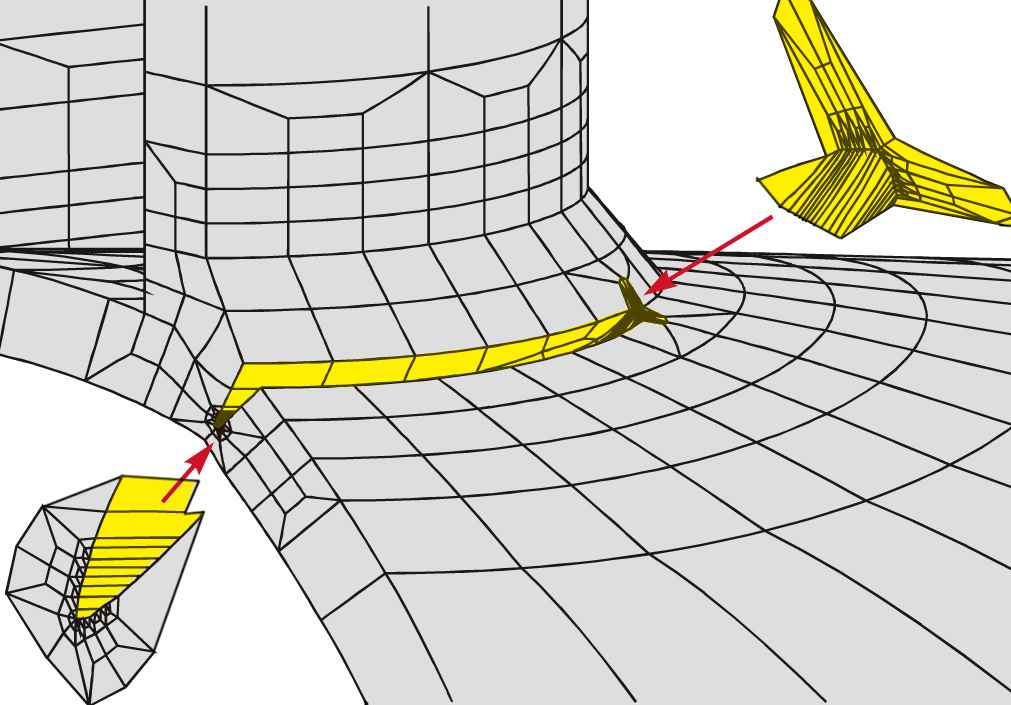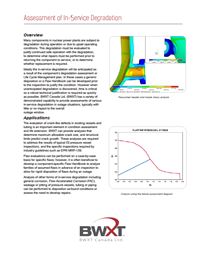OVERVIEW
Many components in nuclear power plants are subject to degradation during operation or due to upset operating conditions. This degradation must be evaluated to justify continued safe operation with the degradation, to determine what repairs must be performed prior to returning the component to service, or to determine whether replacement is required.
Ideally the in-service degradation will be anticipated as a result of the component’s degradation assessment or Life Cycle Management plan. In these cases a generic disposition or a Flaw Handbook can be developed prior to the inspection to justify the condition. However, when unanticipated degradation is discovered, time is critical so a robust technical justification is required as quickly as possible. BWXT has a variety of demonstrated capabilities to provide assessments of various in-service degradation in outage situations, typically with little or no impact to the overall outage window.
APPLICATIONS
The evaluation of crack-like defects in existing vessels and tubing is an important element in condition assessment and life extension. BWXT can provide analyses that determine maximum allowable crack size, and structural limits. These analyses are required to address the results of typical ISI pressure vessel inspections, and the specific inspections required by industry guidelines such as EPRI MRP-139.
Flaw evaluations can be performed on a case-by-case basis for specific flaws; however, it is often beneficial to develop a component-specific Flaw Handbook to analyze families of assumed flaws in advance of an inspection to allow for rapid disposition of flaws during an outage.
Analysis of other forms of in-service degradation including general corrosion, Flow Accelerated Corrosion (FAC), wastage or pitting of pressure vessels, tubing or piping can be performed to disposition as-found conditions or assess the need to develop repairs.
CAPABILITY AND TOOLS
BWXT offers complete engineering capabilities to perform fracture mechanics related analyses and testing for nuclear components and pressure vessels. Fracture mechanics capabilities include, but are not limited to, the following:
- Finite element (FE) modeling of complex geometries to determine stress intensity factors
- FE modeling to determine welding and fabrication residual stresses
- FE crack growth analysis
- Analysis using Failure Assessment Diagrams
- KIc, KIR, JIc, JIR testing
- Development of crack growth rate curves
- ASME Section III Appendix-G analysis
- ASME Section XI crack growth analysis
- US NRC Regulatory Guide 1.121 based tube flaw analysis for steam generators
Finite element software used to perform the above analyses include ANSYS®, ABAQUSTM, and ABACUSTM with VFD. BWXT has extensive experience with the use of ASME Code Section III and Section XI, the US NRC Regulatory Guide 1.121, and British Standards 7910 and R6 flaw assessment procedures. For the evaluation of flaws in tubing, BWXT has experience using the EPRI Steam Generator Integrity Assessment Guidelines and the Flaw Handbook in accordance with NEI 97-06.
BWXT has the capability to analyze similar and dissimilar metal welded joints to include the effects of residual stress in the analysis of flaws.
ANSYS® is a registered trademark of ANSYS, Inc.
ABAQUSTM is a trademark of Dassault Systems.
DESIGNER NOTE!!!! Subscript on bulleted testing elements.


